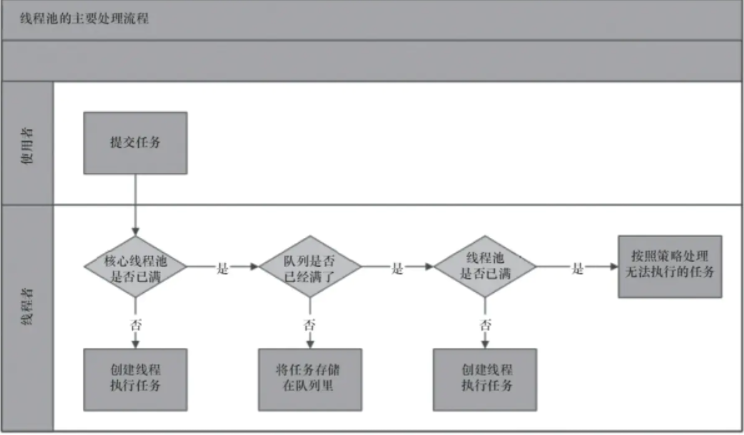ThreadPoolExecutor
线程池
好处:
降低资源的消耗。线程本身就是一种资源。创建和销毁线程会有CPU开销。创建的线程也会占用一定的内存。
提高任务执行的响应速度,执行任务时可以不必等到线程创建完之后在执行。
提高线程的可管理性,线程不能无限的创建,需要进行统一的分配调优监控。
不适用线程池的话,频繁的线程创建和销毁会占用更多的cpu和内存。频繁的线程创建和销毁会对gc产生比较大的压力。线程太多,线程间切换带来的开销将不可忽视,线程太少,多核cpu得不到充分利用,是一种浪费。
可以看出合理使用的线程池是多么重要的事情。
先从线程池的构造函数看起(这里找了个最多参数的):
1
2
3
4
5
6
7
8
9
10
11
12
13
14
15
16
17
18
19
20
21
| public ThreadPoolExecutor(int corePoolSize, // 1
int maximumPoolSize, // 2
long keepAliveTime, // 3
TimeUnit unit, // 4
BlockingQueue<Runnable> workQueue, // 5
ThreadFactory threadFactory, // 6
RejectedExecutionHandler handler ) {
if (corePoolSize < 0 ||
maximumPoolSize <= 0 ||
maximumPoolSize < corePoolSize ||
keepAliveTime < 0)
throw new IllegalArgumentException();
if (workQueue == null || threadFactory == null || handler == null)
throw new NullPointerException();
this.corePoolSize = corePoolSize;
this.maximumPoolSize = maximumPoolSize;
this.workQueue = workQueue;
this.keepAliveTime = unit.toNanos(keepAliveTime);
this.threadFactory = threadFactory;
this.handler = handler;
}
|
| 序号 |
名称 |
类型 |
含义 |
| 1 |
corePoolSize |
int |
线程池里的核心线程数量 |
| 2 |
maximumPoolSize |
int |
线程池里允许有的最大线程数量 |
| 3 |
keepAliveTime |
long |
线程最大空闲等待时间 |
| 4 |
unit |
TimeUnit |
时间单位分时秒 |
| 5 |
workQueue |
BlockingQueue Runable |
线程等待队列 |
| 6 |
threadFactory |
ThreadFactory |
线程创建工厂 |
| 7 |
handler |
RejectedExecutionHandler |
拒绝策略 |
corePoolSize线程池里面的核心线程池,这里面的线程是并行的,并行和并发是两个概念,并发是CPU切换的速度快到人们感受不到所以认为任务是在一起允许。而并行则是真正的在一起执行,这需要我们的CPU拥有多个核心才行。比如我的电脑是8核16线程,则代表我的这台电脑在同一时间可以并行允许16个线程。这里有个Demo可以自己跑起来看下:
1
2
3
4
5
6
7
8
9
10
11
12
13
14
15
16
17
18
19
20
21
22
23
24
25
26
27
28
29
30
31
32
33
34
35
36
| public class ThreadPoolDemo {
public static void main(String[] args) {
ThreadPoolDemo threadPoolDemo = new ThreadPoolDemo();
threadPoolDemo.doPricess();
}
void doPricess(){
ExecutorService executorService = null;
executorService = new ThreadPoolExecutor(16,
16,60, TimeUnit.SECONDS,new LinkedBlockingDeque<>());
for(int i=0;i<40;i++){
TestPoolThreadRunnable thread = new TestPoolThreadRunnable(i);
executorService.execute(thread);
}
executorService.shutdown();
}
class TestPoolThreadRunnable implements Runnable{
Integer count;
TestPoolThreadRunnable(Integer count){
this.count = count;
}
@Override
public void run() {
try {
Thread.sleep(1000);
} catch (InterruptedException e) {
e.printStackTrace();
}
System.out.println(count++ +" "+ Thread.currentThread().getId());
}
}
}
|
触发问题:java.util.concurrent.RejectedExecutionException:这个错误的意思就是往线程池里面提交的任务被拒绝了。那什么情况下会出现线程被线程池拒绝呢?
- 当线程等待队列用的是有限的比如
SynchronousQueue这个队列,当我们的核心线程满了,然后队列也满了然后运行的最大线程数量也就是(maximumPoolSize)也满了,这个时候就会报RejectedExecutionException奔溃。
- 当线程池显示的调用了shutDown方法后,线程池又去提交了任务,这个时候就会报这个错误。
1
2
3
4
5
6
7
8
9
10
11
12
13
14
15
16
17
18
19
20
21
22
23
24
25
26
27
28
29
30
31
32
33
34
35
36
37
38
|
public class ThreadPoolDemo {
public static void main(String[] args) {
ThreadPoolDemo threadPoolDemo = new ThreadPoolDemo();
try {
threadPoolDemo.doPricess();
} catch (InterruptedException e) {
e.printStackTrace();
}
}
ExecutorService executorService = null;
void doPricess() throws InterruptedException {
executorService = new ThreadPoolExecutor(5,
8,60, TimeUnit.SECONDS,new LinkedBlockingDeque<>());
for(int i=0;i<40;i++){
TestPoolThreadRunnable thread = new TestPoolThreadRunnable(i);
executorService.execute(thread);
executorService.shutdown();
}
}
class TestPoolThreadRunnable implements Runnable{
Integer count;
TestPoolThreadRunnable(Integer count){
this.count = count;
}
@Override
public void run() {
try {
Thread.sleep(1000);
} catch (InterruptedException e) {
e.printStackTrace();
}
System.out.println(count++ +" "+ Thread.currentThread().getId()+" "+System.currentTimeMillis());
}
}
}
|
